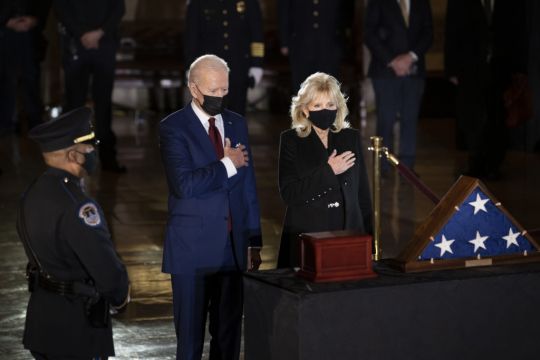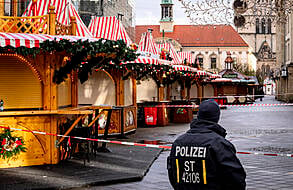Slain US Capitol police officer Brian Sicknick was lying in honour in the famed domed building on Tuesday evening, allowing his colleagues and the politicians he protected to pay their respects and to remember the violent attack on Congress that took his life.
Mr Sicknick died after defending the Capitol on January 6 against the mob that stormed the building and interrupted the electoral count after then-President Donald Trump urged supporters on the National Mall to “fight like hell” to overturn his defeat.
The US Capitol Police said in a statement that Mr Sicknick, who died the next day, was injured “while physically engaging with protesters”, though a final cause of death has not yet been determined.

The arrival of Mr Sicknick’s remains on Tuesday evening was solemn, with dozens of Capitol Police standing at attention as his urn was carried up the Capitol steps. A viewing period was reserved for Capitol police overnight, with legislators to pay tribute at a ceremony on Wednesday morning.
A ceremonial departure for Arlington National Cemetery was planned for later in the day.
Members of Congress remain shaken by the attack and are grappling with what it means not only for the future of the country, but for their own security as elected representatives. While politicians were united in denouncing the riots and Mr Trump’s role in them, the parties are now largely split on how to move forward.

House Democrats impeached Mr Trump a week after the attack, sending a charge of “incitement of insurrection” to the Senate, where Republicans are unlikely to provide the votes necessary to convict him. At the same time, the building has been cut off from the public, surrounded by large metal fences and defended by the National Guard.
Mr Sicknick, 42, of South River, New Jersey, enlisted in the National Guard six months after graduating from high school in 1997, then deployed to Saudi Arabia and later Kyrgyzstan.
He joined the Capitol Police in 2008. Like many Capitol Police officers, he often worked on security in the Capitol itself and was known to politicians, staff and others who passed through the building’s doors each morning.







